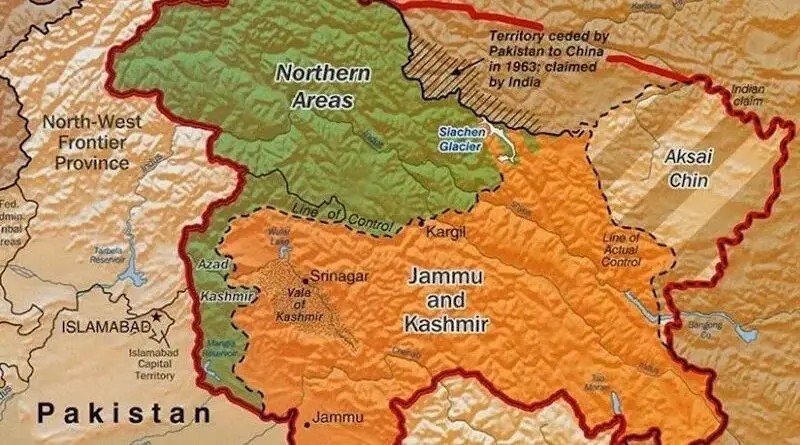India’s Kashmir Strategy: A Model for Proxy Wars
India’s Kashmir Strategy: A Model for Proxy Wars
Syllabus:
GS-2:
India and its Neighbourhood , Groupings & Agreements Involving India and/or Affecting India’s Interests
GS-3:
Challenges to Internal Security Through Communication Networks
Focus:
The recent terrorist attacks on tourists in Pahalgam have reignited concerns over Pakistan-backed proxy wars in Jammu & Kashmir. These events spotlight India’s long-term counterterrorism strategy, which combines targeted military action, democratic resilience, and institutional reforms, offering critical global lessons for conflict zones facing asymmetric warfare.
Understanding the Context: Proxy Wars and Terrorism
Pakistan’s Role in Undermining Stability
- Pakistan continues its policy of sponsoring cross-border terrorism, targeting civilians and tourists in Jammu & Kashmir.
- The recent killings in Pahalgam reflect a persistent pattern of proxy war to undermine India’s democratic institutions.
- The Pakistan Army’s ideology still rests on the two-nation theory and Bhutto’s “jugular vein” metaphor, aimed at destabilizing India.
Global Parallels and Ignored Lessons
- The 1975 U.S. withdrawal from Vietnam symbolizes the failure of force-heavy counterinsurgency in proxy wars.
- America’s reliance on brute military power (e.g., napalm, Agent Orange) did not ensure victory or legitimacy.
- Proposals like “emptying Gaza” echo the same strategic blindness, ignoring lessons from Vietnam, Iraq, and Afghanistan.
About Jammu and Kashmir as a Battleground of Proxy War:Historical Background● Pakistan’s military confrontations with India in 1947, 1965, and 1971 ended in defeat; 1971 led to Bangladesh’s creation. Terrorism and Separatism●In the late 1980s, Pakistan-backed insurgency began using JKLF (Jammu and Kashmir Liberation Front); Yasin Malik later denounced violence. Internal Factors●Disputed 1987 elections, lack of development, unemployment, and militarization fueled youth alienation and radicalization. Tactics of Irregular Warfare●Psychological warfare via propaganda, IT tools for recruitment, and crowd mobilization. Human Rights Concerns● Allegations against Indian forces: AFSPA misuse, pellet guns, detentions, and extrajudicial killings. India’s Strategic Shift●Operation All-Out launched to flush out terrorists. |
India’s Strategic Shift in Kashmir:
From Forceful Repression to Strategic Containment
- Since the 1990s, India shifted from blunt military tactics to intelligence-based operations.
- Formation of Rashtriya Rifles (1990), Special Operations Group (1993), and the CRPF’s internal security role (1995) marked a professionalization of counter-terrorism.
Cutting Terror’s Lifeline: Financial Networks
- The National Investigation Agency (NIA) replaced the CBI in dealing with terror financing.
- The NIA’s action led to the disruption of Hawala networks and illegal funding chains.
Key Pillars of India’s Long-Term Counter-Terror Strategy:
Specialisation in Security Operations
- Recognition of the need for targeted force, replacing blunt operations with precision raids.
- Security institutions were reformed to enhance local intelligence, community engagement, and surgical strikes.
- Shift from “search and destroy” to “target, limit, and build” yielded greater legitimacy.
Emphasis on Moderation over Aggression
- Unlike the US’s excessive militarization in Vietnam, India’s approach emphasized minimum use of force.
- Key examples:
- Hazratbal siege (1993): Terrorists surrendered
- 2024 voter turnout in Kashmir: Shows increased public trust in the system.
- India followed the WWII Marine Manual’s advice: win hearts and minds through sympathy, tolerance, and minimal violence.
Upholding Democracy and Civil Governance
- Regular elections in J&K, even during Governor’s Rule, showcased India’s democratic commitment.
- Civil servants, bureaucrats, and politicians played a constant role in governance.
- Even soft separatists were allowed political space, promoting mainstream integration.
Contemporary Outcomes and Global Implications:
Kashmir’s Changing Landscape
- After the abrogation of Article 370, there has been greater political participation, and reduced militancy.
- Focus on infrastructure development, including railway connectivity, is transforming economic prospects.
Global Isolation of Radicalism
- India’s diplomatic efforts have succeeded in isolating Pakistan on the global stage.
- Strategic ties with Gulf nations and Western democracies have strengthened India’s international legitimacy.
Strategic Autonomy and National Strength
- India’s strategic autonomy has replaced Cold War alignments, empowering it to act independently.
- Economic growth and military modernization have bolstered national resilience against external threats.
Lessons for the World from the ‘India Way’:
Lesson 1: Build Targeted, Intelligence-Led Forces
- Specialized units like Rashtriya Rifles, NIA, and SOG show how intelligence-driven operations are more effective.
- They reduce collateral damage and help gain local support.
Lesson 2: Exercise Force with Restraint
- Excessive use of force often backfires, as seen in Vietnam.
- India’s approach of measured response, with minimal violence, yields long-term peace dividends.
Lesson 3: Democratize Conflict Zones
- Regular elections, bureaucratic oversight, and inclusive governance reduce alienation.
- Political inclusion and civil engagement counter radical ideologies effectively.
Conclusion:
India’s Kashmir approach—marked by specialized intelligence operations, moderation in force, and democratic governance—has effectively contained terrorism while preserving institutional legitimacy. It demonstrates how a people-centric, calibrated strategy can defeat proxy wars. The global community can adopt this model to protect national security and uphold democratic values.
Source:IE
Mains Practice Question:
Discuss how India’s counterterrorism strategy in Jammu & Kashmir balances use of force with democratic inclusion. What lessons does it offer to nations facing proxy wars and internal insurgencies? Analyze the role of security institutions, civil society, and diplomatic engagement in India’s evolving national security doctrine.





